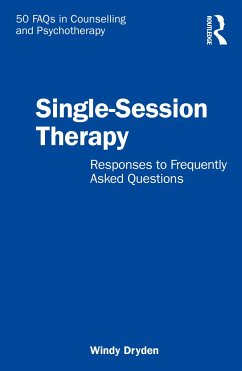Windy Dryden (Goldsmiths, University of London, UK)
Single-Session Therapy
Responses to Frequently Asked Questions
Windy Dryden (Goldsmiths, University of London, UK)
Single-Session Therapy
Responses to Frequently Asked Questions
- Broschiertes Buch
- Merkliste
- Auf die Merkliste
- Bewerten Bewerten
- Teilen
- Produkt teilen
- Produkterinnerung
- Produkterinnerung
- Weitere 7 Ausgaben:
- Broschiertes Buch
- eBook, ePUB
- eBook, ePUB
- eBook, ePUB
- eBook, PDF
- eBook, PDF
- eBook, PDF
In Single-Session Therapy: Responses to Frequently Asked Questions, Windy Dryden takes the questions raised by participants from his workshops and training events on SST and provides answers in a fresh and accessible format.
Andere Kunden interessierten sich auch für
![Single-Session Therapy Single-Session Therapy]() Windy Dryden (Goldsmiths, University of London, UK)Single-Session Therapy28,99 €
Windy Dryden (Goldsmiths, University of London, UK)Single-Session Therapy28,99 €![Rational Emotive Behaviour Therapy Rational Emotive Behaviour Therapy]() Windy DrydenRational Emotive Behaviour Therapy30,99 €
Windy DrydenRational Emotive Behaviour Therapy30,99 €![Single-Session Therapy Single-Session Therapy]() Windy DrydenSingle-Session Therapy21,99 €
Windy DrydenSingle-Session Therapy21,99 €![Single-Session Therapy (SST) Single-Session Therapy (SST)]() Windy DrydenSingle-Session Therapy (SST)21,99 €
Windy DrydenSingle-Session Therapy (SST)21,99 €![Rational Emotive Behaviour Therapy Rational Emotive Behaviour Therapy]() Windy DrydenRational Emotive Behaviour Therapy26,99 €
Windy DrydenRational Emotive Behaviour Therapy26,99 €![How to Think and Intervene Like a Single-Session Therapist How to Think and Intervene Like a Single-Session Therapist]() Windy DrydenHow to Think and Intervene Like a Single-Session Therapist29,99 €
Windy DrydenHow to Think and Intervene Like a Single-Session Therapist29,99 €![Help Yourself with Single-Session Therapy Help Yourself with Single-Session Therapy]() Windy DrydenHelp Yourself with Single-Session Therapy24,99 €
Windy DrydenHelp Yourself with Single-Session Therapy24,99 €-
-
-
In Single-Session Therapy: Responses to Frequently Asked Questions, Windy Dryden takes the questions raised by participants from his workshops and training events on SST and provides answers in a fresh and accessible format.
Produktdetails
- Produktdetails
- 50 FAQs in Counselling and Psychotherapy
- Verlag: Taylor & Francis Ltd
- Seitenzahl: 194
- Erscheinungstermin: 21. Dezember 2021
- Englisch
- Abmessung: 198mm x 129mm x 11mm
- Gewicht: 216g
- ISBN-13: 9781032157368
- ISBN-10: 1032157364
- Artikelnr.: 62799382
- Herstellerkennzeichnung
- Libri GmbH
- Europaallee 1
- 36244 Bad Hersfeld
- gpsr@libri.de
- 50 FAQs in Counselling and Psychotherapy
- Verlag: Taylor & Francis Ltd
- Seitenzahl: 194
- Erscheinungstermin: 21. Dezember 2021
- Englisch
- Abmessung: 198mm x 129mm x 11mm
- Gewicht: 216g
- ISBN-13: 9781032157368
- ISBN-10: 1032157364
- Artikelnr.: 62799382
- Herstellerkennzeichnung
- Libri GmbH
- Europaallee 1
- 36244 Bad Hersfeld
- gpsr@libri.de
Windy Dryden is an Emeritus Professor of Psychotherapeutic Studies at Goldsmiths University of London and is in part-time independent practice. His interests are in REBT, single-session therapy and very brief interventions and promoting self-help.Professor Dryden has written or edited over 280 books.
Introduction; Part 1: The Nature of Single-Session Therapy; Question 1:
What is Single-Session Therapy?; Question 2: Why is it Called
Single-Session Therapy if Further Sessions are Available?; Question 3: What
are the Differences, If Any, Between Single-Session Therapy (SST) and
One-At-A-Time (OAAT) Therapy?; Question 4: Is Single-Session Therapy
Psychotherapy? Is it Counselling?; Question 5: Is Single-Session Therapy an
Approach to Therapy?; Question 6: What is Meant by Single-Session
Thinking?; Part 2: The Foundations of Single-Session Therapy Practice;
Question 7: How Can a Therapy Agency Integrate Single-Session Therapy into
its Overall Service Delivery?; Question 8: Can a Therapist Form an
Effective Therapeutic Relationship with a Client in Single-Session
Therapy?; Question 9: How Can a Therapist Develop a Relationship of Depth
with Their SST Clients?; Question 10: How is a Client's Suitability for SST
Assessed?; Question 11: Is it Possible to Practise SST when a Therapist is
Required to Carry Out an Assessment?; Question 12: Why Would a Client Seek
Single-Session Therapy?; Question 13: Is SST Suitable for a Client Who
Wants to Explore a Problem Rather than Solve a Problem?; Question 14: Which
Client Problems are Suitable and Which are Unsuitable for SST?; Question
15: Can SST be Used with Clients Who Have Severe, Complex or Chronic
Problems or Is It Only Suitable for Simple Problems?; Question 16: What
Does a Therapist Need to Know About a Client Beforehand to Practise SST?;
Part 3: The Practice of SST; Question 17: Is Single-Session Therapy for All
Clients?; Question 18: Can a Therapist Work Productively in SST with a
Client Who Cannot Easily Pinpoint a Specific Problem They Wish to Tackle?;
Question 19: Can Clients Get What They Need From SST?; Question 20: Which
Client Factors Contribute to a Good Outcome or a Poor Outcome in SST?;
Question 21: What Does a Client Need to Know about SST Beforehand to Get
the Most from the Session?; Question 22: Can a Client Be Helped to Prepare
for the Session in SST?; Question 23: What is the Best Way to Start a
Session in SST?; Question 24: Are Sessions in SST Longer than Sessions in
Ongoing Therapy?; Question 25: How Does a Therapist Manage Risk in SST?;
Question 26: Which Therapist Factors Contribute to A Good Client Outcome
from SST and Which Therapist Factors Contribute to a Poor Client Outcome?;
Question 27: What Tips Can You Give to Help Therapists Become Focused and
Stay Focused in the Session?; Question 28: What Do Therapists Most Struggle
with When Practising SST?; Question 29: Can All Therapists Practise SST?;
Question 30: Is SST Easier to Practise than Longer-Term Therapy?; Question
31: Is There a Protocol to be Followed While Practising SST?; Question 32:
Suppose the Modal Number of Sessions is One and 70%-80% of These Clients
Find that Session Sufficient Given Their Current Circumstances. Given that
in Most Therapies, the First Session is Taken Up with History-Taking and
Assessment Rather than Therapy, Does This Mean that These Clients Who
Attend Once are Helped by a Single Session of History-Taking and
Assessment?; Question 33: How Can a Therapist Best Bring a Single Session
to an End?; Question 34: How Does a Therapist Know When to Offer a Client
Further Help at the End of a Single Session?; Question 35: In Which Formats
and With Which Client Groups Can SST Be Used?; Question 36: Can Clients Be
Harmed in SST?; Part 4: Critical Questions about SST; Question 37:
Treatment Protocols are Based on the Idea that Therapy for Specific
Conditions Should Have a Set Number of Sessions (e.g. 12 or 16 Sessions).
Doesn't This Conflict with SST?; Question 38: Doesn't SST Involve a
Therapist Cramming Several Sessions Into One?; Question 39: Isn't SST
Crisis Intervention?; Question 40: Does SST Only Lead to Superficial
Change, Given that Real Change Happens Slowly and Gradually?; Question 41:
Doesn't SST Help Clients Deal with Their Presenting Problems Rather than
with Their Real Underlying Problems?; Question 42: Isn't SST Just a
Sticking-Plaster Solution or A Quick Fix?; Question 43: Does SST Restrict
Clients' Access to Therapy?; Question 44: Isn't SST Used for Purely
Pragmatic Reasons such as to Bring Down Waiting Lists and to Save Agencies
Money? If So, What Are the Implications for Clients and Therapists?; Part
5: Miscellaneous Questions; Question 45: Is SST on the Curriculum of
Therapy Training Courses?; Question 46: What Training is Necessary to
Practise SST?; Question 47: What Challenges Have You Faced When Practising
SST?; Question 48: Which Ideas Have You Personally Found Most Useful in
SST?; Question 49: How Should SST Services Be Disseminated?; Question 50:
Can Single-Session Thinking Be Applied to Areas of Work Other Than Therapy?
What is Single-Session Therapy?; Question 2: Why is it Called
Single-Session Therapy if Further Sessions are Available?; Question 3: What
are the Differences, If Any, Between Single-Session Therapy (SST) and
One-At-A-Time (OAAT) Therapy?; Question 4: Is Single-Session Therapy
Psychotherapy? Is it Counselling?; Question 5: Is Single-Session Therapy an
Approach to Therapy?; Question 6: What is Meant by Single-Session
Thinking?; Part 2: The Foundations of Single-Session Therapy Practice;
Question 7: How Can a Therapy Agency Integrate Single-Session Therapy into
its Overall Service Delivery?; Question 8: Can a Therapist Form an
Effective Therapeutic Relationship with a Client in Single-Session
Therapy?; Question 9: How Can a Therapist Develop a Relationship of Depth
with Their SST Clients?; Question 10: How is a Client's Suitability for SST
Assessed?; Question 11: Is it Possible to Practise SST when a Therapist is
Required to Carry Out an Assessment?; Question 12: Why Would a Client Seek
Single-Session Therapy?; Question 13: Is SST Suitable for a Client Who
Wants to Explore a Problem Rather than Solve a Problem?; Question 14: Which
Client Problems are Suitable and Which are Unsuitable for SST?; Question
15: Can SST be Used with Clients Who Have Severe, Complex or Chronic
Problems or Is It Only Suitable for Simple Problems?; Question 16: What
Does a Therapist Need to Know About a Client Beforehand to Practise SST?;
Part 3: The Practice of SST; Question 17: Is Single-Session Therapy for All
Clients?; Question 18: Can a Therapist Work Productively in SST with a
Client Who Cannot Easily Pinpoint a Specific Problem They Wish to Tackle?;
Question 19: Can Clients Get What They Need From SST?; Question 20: Which
Client Factors Contribute to a Good Outcome or a Poor Outcome in SST?;
Question 21: What Does a Client Need to Know about SST Beforehand to Get
the Most from the Session?; Question 22: Can a Client Be Helped to Prepare
for the Session in SST?; Question 23: What is the Best Way to Start a
Session in SST?; Question 24: Are Sessions in SST Longer than Sessions in
Ongoing Therapy?; Question 25: How Does a Therapist Manage Risk in SST?;
Question 26: Which Therapist Factors Contribute to A Good Client Outcome
from SST and Which Therapist Factors Contribute to a Poor Client Outcome?;
Question 27: What Tips Can You Give to Help Therapists Become Focused and
Stay Focused in the Session?; Question 28: What Do Therapists Most Struggle
with When Practising SST?; Question 29: Can All Therapists Practise SST?;
Question 30: Is SST Easier to Practise than Longer-Term Therapy?; Question
31: Is There a Protocol to be Followed While Practising SST?; Question 32:
Suppose the Modal Number of Sessions is One and 70%-80% of These Clients
Find that Session Sufficient Given Their Current Circumstances. Given that
in Most Therapies, the First Session is Taken Up with History-Taking and
Assessment Rather than Therapy, Does This Mean that These Clients Who
Attend Once are Helped by a Single Session of History-Taking and
Assessment?; Question 33: How Can a Therapist Best Bring a Single Session
to an End?; Question 34: How Does a Therapist Know When to Offer a Client
Further Help at the End of a Single Session?; Question 35: In Which Formats
and With Which Client Groups Can SST Be Used?; Question 36: Can Clients Be
Harmed in SST?; Part 4: Critical Questions about SST; Question 37:
Treatment Protocols are Based on the Idea that Therapy for Specific
Conditions Should Have a Set Number of Sessions (e.g. 12 or 16 Sessions).
Doesn't This Conflict with SST?; Question 38: Doesn't SST Involve a
Therapist Cramming Several Sessions Into One?; Question 39: Isn't SST
Crisis Intervention?; Question 40: Does SST Only Lead to Superficial
Change, Given that Real Change Happens Slowly and Gradually?; Question 41:
Doesn't SST Help Clients Deal with Their Presenting Problems Rather than
with Their Real Underlying Problems?; Question 42: Isn't SST Just a
Sticking-Plaster Solution or A Quick Fix?; Question 43: Does SST Restrict
Clients' Access to Therapy?; Question 44: Isn't SST Used for Purely
Pragmatic Reasons such as to Bring Down Waiting Lists and to Save Agencies
Money? If So, What Are the Implications for Clients and Therapists?; Part
5: Miscellaneous Questions; Question 45: Is SST on the Curriculum of
Therapy Training Courses?; Question 46: What Training is Necessary to
Practise SST?; Question 47: What Challenges Have You Faced When Practising
SST?; Question 48: Which Ideas Have You Personally Found Most Useful in
SST?; Question 49: How Should SST Services Be Disseminated?; Question 50:
Can Single-Session Thinking Be Applied to Areas of Work Other Than Therapy?
Introduction; Part 1: The Nature of Single-Session Therapy; Question 1:
What is Single-Session Therapy?; Question 2: Why is it Called
Single-Session Therapy if Further Sessions are Available?; Question 3: What
are the Differences, If Any, Between Single-Session Therapy (SST) and
One-At-A-Time (OAAT) Therapy?; Question 4: Is Single-Session Therapy
Psychotherapy? Is it Counselling?; Question 5: Is Single-Session Therapy an
Approach to Therapy?; Question 6: What is Meant by Single-Session
Thinking?; Part 2: The Foundations of Single-Session Therapy Practice;
Question 7: How Can a Therapy Agency Integrate Single-Session Therapy into
its Overall Service Delivery?; Question 8: Can a Therapist Form an
Effective Therapeutic Relationship with a Client in Single-Session
Therapy?; Question 9: How Can a Therapist Develop a Relationship of Depth
with Their SST Clients?; Question 10: How is a Client's Suitability for SST
Assessed?; Question 11: Is it Possible to Practise SST when a Therapist is
Required to Carry Out an Assessment?; Question 12: Why Would a Client Seek
Single-Session Therapy?; Question 13: Is SST Suitable for a Client Who
Wants to Explore a Problem Rather than Solve a Problem?; Question 14: Which
Client Problems are Suitable and Which are Unsuitable for SST?; Question
15: Can SST be Used with Clients Who Have Severe, Complex or Chronic
Problems or Is It Only Suitable for Simple Problems?; Question 16: What
Does a Therapist Need to Know About a Client Beforehand to Practise SST?;
Part 3: The Practice of SST; Question 17: Is Single-Session Therapy for All
Clients?; Question 18: Can a Therapist Work Productively in SST with a
Client Who Cannot Easily Pinpoint a Specific Problem They Wish to Tackle?;
Question 19: Can Clients Get What They Need From SST?; Question 20: Which
Client Factors Contribute to a Good Outcome or a Poor Outcome in SST?;
Question 21: What Does a Client Need to Know about SST Beforehand to Get
the Most from the Session?; Question 22: Can a Client Be Helped to Prepare
for the Session in SST?; Question 23: What is the Best Way to Start a
Session in SST?; Question 24: Are Sessions in SST Longer than Sessions in
Ongoing Therapy?; Question 25: How Does a Therapist Manage Risk in SST?;
Question 26: Which Therapist Factors Contribute to A Good Client Outcome
from SST and Which Therapist Factors Contribute to a Poor Client Outcome?;
Question 27: What Tips Can You Give to Help Therapists Become Focused and
Stay Focused in the Session?; Question 28: What Do Therapists Most Struggle
with When Practising SST?; Question 29: Can All Therapists Practise SST?;
Question 30: Is SST Easier to Practise than Longer-Term Therapy?; Question
31: Is There a Protocol to be Followed While Practising SST?; Question 32:
Suppose the Modal Number of Sessions is One and 70%-80% of These Clients
Find that Session Sufficient Given Their Current Circumstances. Given that
in Most Therapies, the First Session is Taken Up with History-Taking and
Assessment Rather than Therapy, Does This Mean that These Clients Who
Attend Once are Helped by a Single Session of History-Taking and
Assessment?; Question 33: How Can a Therapist Best Bring a Single Session
to an End?; Question 34: How Does a Therapist Know When to Offer a Client
Further Help at the End of a Single Session?; Question 35: In Which Formats
and With Which Client Groups Can SST Be Used?; Question 36: Can Clients Be
Harmed in SST?; Part 4: Critical Questions about SST; Question 37:
Treatment Protocols are Based on the Idea that Therapy for Specific
Conditions Should Have a Set Number of Sessions (e.g. 12 or 16 Sessions).
Doesn't This Conflict with SST?; Question 38: Doesn't SST Involve a
Therapist Cramming Several Sessions Into One?; Question 39: Isn't SST
Crisis Intervention?; Question 40: Does SST Only Lead to Superficial
Change, Given that Real Change Happens Slowly and Gradually?; Question 41:
Doesn't SST Help Clients Deal with Their Presenting Problems Rather than
with Their Real Underlying Problems?; Question 42: Isn't SST Just a
Sticking-Plaster Solution or A Quick Fix?; Question 43: Does SST Restrict
Clients' Access to Therapy?; Question 44: Isn't SST Used for Purely
Pragmatic Reasons such as to Bring Down Waiting Lists and to Save Agencies
Money? If So, What Are the Implications for Clients and Therapists?; Part
5: Miscellaneous Questions; Question 45: Is SST on the Curriculum of
Therapy Training Courses?; Question 46: What Training is Necessary to
Practise SST?; Question 47: What Challenges Have You Faced When Practising
SST?; Question 48: Which Ideas Have You Personally Found Most Useful in
SST?; Question 49: How Should SST Services Be Disseminated?; Question 50:
Can Single-Session Thinking Be Applied to Areas of Work Other Than Therapy?
What is Single-Session Therapy?; Question 2: Why is it Called
Single-Session Therapy if Further Sessions are Available?; Question 3: What
are the Differences, If Any, Between Single-Session Therapy (SST) and
One-At-A-Time (OAAT) Therapy?; Question 4: Is Single-Session Therapy
Psychotherapy? Is it Counselling?; Question 5: Is Single-Session Therapy an
Approach to Therapy?; Question 6: What is Meant by Single-Session
Thinking?; Part 2: The Foundations of Single-Session Therapy Practice;
Question 7: How Can a Therapy Agency Integrate Single-Session Therapy into
its Overall Service Delivery?; Question 8: Can a Therapist Form an
Effective Therapeutic Relationship with a Client in Single-Session
Therapy?; Question 9: How Can a Therapist Develop a Relationship of Depth
with Their SST Clients?; Question 10: How is a Client's Suitability for SST
Assessed?; Question 11: Is it Possible to Practise SST when a Therapist is
Required to Carry Out an Assessment?; Question 12: Why Would a Client Seek
Single-Session Therapy?; Question 13: Is SST Suitable for a Client Who
Wants to Explore a Problem Rather than Solve a Problem?; Question 14: Which
Client Problems are Suitable and Which are Unsuitable for SST?; Question
15: Can SST be Used with Clients Who Have Severe, Complex or Chronic
Problems or Is It Only Suitable for Simple Problems?; Question 16: What
Does a Therapist Need to Know About a Client Beforehand to Practise SST?;
Part 3: The Practice of SST; Question 17: Is Single-Session Therapy for All
Clients?; Question 18: Can a Therapist Work Productively in SST with a
Client Who Cannot Easily Pinpoint a Specific Problem They Wish to Tackle?;
Question 19: Can Clients Get What They Need From SST?; Question 20: Which
Client Factors Contribute to a Good Outcome or a Poor Outcome in SST?;
Question 21: What Does a Client Need to Know about SST Beforehand to Get
the Most from the Session?; Question 22: Can a Client Be Helped to Prepare
for the Session in SST?; Question 23: What is the Best Way to Start a
Session in SST?; Question 24: Are Sessions in SST Longer than Sessions in
Ongoing Therapy?; Question 25: How Does a Therapist Manage Risk in SST?;
Question 26: Which Therapist Factors Contribute to A Good Client Outcome
from SST and Which Therapist Factors Contribute to a Poor Client Outcome?;
Question 27: What Tips Can You Give to Help Therapists Become Focused and
Stay Focused in the Session?; Question 28: What Do Therapists Most Struggle
with When Practising SST?; Question 29: Can All Therapists Practise SST?;
Question 30: Is SST Easier to Practise than Longer-Term Therapy?; Question
31: Is There a Protocol to be Followed While Practising SST?; Question 32:
Suppose the Modal Number of Sessions is One and 70%-80% of These Clients
Find that Session Sufficient Given Their Current Circumstances. Given that
in Most Therapies, the First Session is Taken Up with History-Taking and
Assessment Rather than Therapy, Does This Mean that These Clients Who
Attend Once are Helped by a Single Session of History-Taking and
Assessment?; Question 33: How Can a Therapist Best Bring a Single Session
to an End?; Question 34: How Does a Therapist Know When to Offer a Client
Further Help at the End of a Single Session?; Question 35: In Which Formats
and With Which Client Groups Can SST Be Used?; Question 36: Can Clients Be
Harmed in SST?; Part 4: Critical Questions about SST; Question 37:
Treatment Protocols are Based on the Idea that Therapy for Specific
Conditions Should Have a Set Number of Sessions (e.g. 12 or 16 Sessions).
Doesn't This Conflict with SST?; Question 38: Doesn't SST Involve a
Therapist Cramming Several Sessions Into One?; Question 39: Isn't SST
Crisis Intervention?; Question 40: Does SST Only Lead to Superficial
Change, Given that Real Change Happens Slowly and Gradually?; Question 41:
Doesn't SST Help Clients Deal with Their Presenting Problems Rather than
with Their Real Underlying Problems?; Question 42: Isn't SST Just a
Sticking-Plaster Solution or A Quick Fix?; Question 43: Does SST Restrict
Clients' Access to Therapy?; Question 44: Isn't SST Used for Purely
Pragmatic Reasons such as to Bring Down Waiting Lists and to Save Agencies
Money? If So, What Are the Implications for Clients and Therapists?; Part
5: Miscellaneous Questions; Question 45: Is SST on the Curriculum of
Therapy Training Courses?; Question 46: What Training is Necessary to
Practise SST?; Question 47: What Challenges Have You Faced When Practising
SST?; Question 48: Which Ideas Have You Personally Found Most Useful in
SST?; Question 49: How Should SST Services Be Disseminated?; Question 50:
Can Single-Session Thinking Be Applied to Areas of Work Other Than Therapy?









